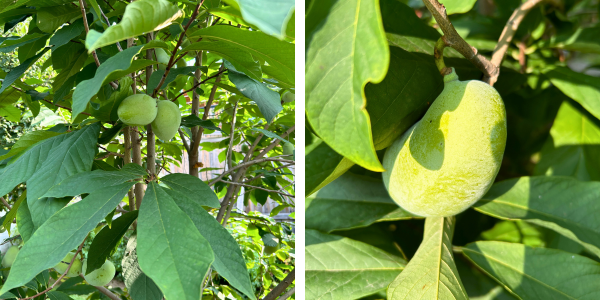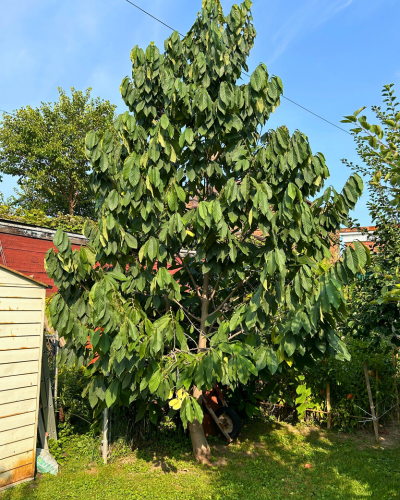Curious to learn more about Anton’s experiences and his passion for native trees, LEAF’s Residential Planting Programs Field Assistant, Joel, sat down with him in September 2024 for a conversation. From his first Backyard Tree Planting Program consultation to his recent pawpaw harvest, Anton shared his insights and stories as a dedicated LEAF client.

Why did you choose to plant pawpaw trees in your yard?
“Pawpaw had always intrigued me, especially since it’s a native tree,” said Anton. “When I saw LEAF’s promotion, I knew I had to give it a try.”
For Anton, gardening is more than a hobby—it’s a source of solace, motivation and joy. “I’ve always had a garden. I grow tomatoes and other plants and experiment with what thrives,” he shared. “I love the idea of being a small-scale grower, sharing my harvest and bringing back native species like the pawpaw.”

What features of your pawpaw trees do you like best and how has this added value to your home?
“They have a unique structure, distinctive leaves and fascinating morphology. We planted them in 2016 but didn’t see fruit until 2022, when we harvested just two. Last year, we had about 30 fruit, and this year we probably have 80 or more,” said Anton. “Pawpaws come in all shapes and sizes, and this season’s harvest has been especially rewarding. The larger fruits are really juicy this year, likely due to a combination of favourable conditions and the trees maturing into their prime.”
Tell us about the rest of your yard and how it added value to your home?
“I grow a variety of pollinator plants, including a huge stand of Joe Pye weed,” said Anton. “In recent years, I’ve encouraged the milkweed that’s always been part of my garden. The fruit trees bloom first, attracting all kinds of bees. I also let the ragweed grow through the season and allow my basil and oregano to flower, because the bees love them. There are so many bees, and it’s fascinating to see their preferences.”

“I have noticed a trend in urban areas where lawns and backyards have been paved over with concrete and asphalt and trees have been removed,” he added. “Some people also use meticulous farming techniques for their tomatoes, but I let mine grow naturally. In the heat of summer, I let the tomatoes crowd together, which helps keep the soil moist. While there are more slugs, the plants last longer in extreme conditions and need less water because the soil isn’t baking in the sun.
“Value is all relative,” he continued. “Some people would see this and fall in love, but many would want to clear it all out. I think the latter is still the majority, but that’s changing—it all comes in cycles. I always joke that I’m too old and too lazy, but really, this is just the way I want to do it. My backyard is my sanctuary, and I’ve embraced this jungle.”

How would you describe your overall experience with LEAF?
“Wonderful – just wonderful,” said Anton. “LEAF is a beautiful niche within the crazy bureaucracy of large cities, and I love their philosophy.”
“As for the trees, I think they’re marvelous and they attract lots of birds. My mother, who lived with us for the last five years before she passed, always made sure to feed the birds. I’ve kept up her tradition because it reminds me of her every day. She was a savior to me so many times growing up, and I’m grateful for the opportunity to continue something she loved. Plus, I just enjoy watching the birds.”
“I love experimenting in the garden and trying something new every year. That’s my philosophy, and it keeps me excited. This is my favorite time of year, when I can sit back and see the results of it all. In many ways, my experience with LEAF reflects that same sense of discovery and appreciation for nature.”
Anton’s approach to home gardening and food production is sustainable, low-maintenance and ecosystem-friendly, helping to support native pollinators and other wildlife. It also aligns wonderfully with LEAF’s commitment to planting native species and growing the urban forest. Thank you, Anton, for your dedication to enhancing the urban forest!
Join the movement to re-establish this delicious native fruit tree in your own backyard by planting pawpaws through LEAF! Pawpaw pairs are available during our spring season only and are sold on a first come, first served basis. Visit our Shrubs and Pawpaws page to learn more and apply!
Joel is the Residential Planting Programs Field Assistant at LEAF.
LEAF offers a subsidized Backyard Tree Planting Program for private property. The program is supported by the City of Toronto, the Regional Municipality of York, the City of Markham, the Town of Newmarket, the Regional Municipality of Durham, the Town of Ajax, the Township of Brock, the Municipality of Clarington, the City of Oshawa, the City of Pickering, the Township of Scugog, the Town of Whitby and Ontario Power Generation.
